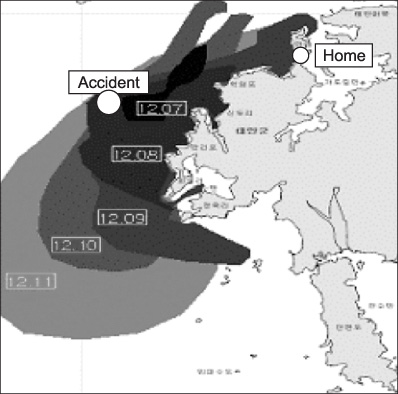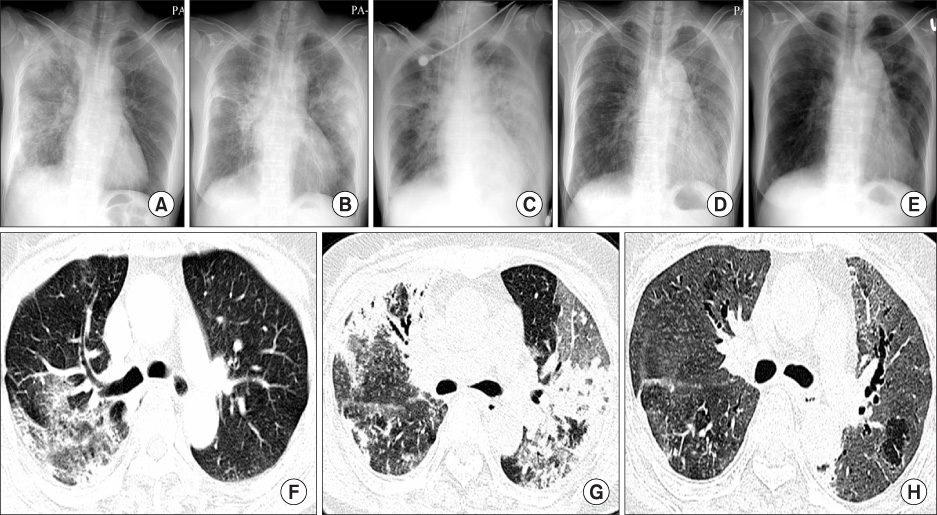Tuberc Respir Dis.
2009 Sep;67(3):249-253.
A Case of Respiratory Failure after Clean-up Work of the Hebei Spirit Crude Oil Spill in Taean
- Affiliations
-
- 1Department of Internal Medicine, Gil Medical Center, Gachon University of Medicine and Science, Incheon, Korea. jwpark@gilhospital.com
Abstract
- On 7 December 2007, the Hebei Spirit ran aground near Taean and released approximately 10,900 tons of oil into the sea. Crude oil on the coastal areas and fumes in the air increased the number of health problems among the local population. We report a case of respiratory failure after the oil spill clean-up work. A 66-year-old female was admitted to hospital with cough, sputum, and dyspnea of 1-month duration after the oil spill clean-up. She was diagnosed with community-acquired pneumonia and treated with empirical antibiotics. However, she had progressive respiratory failure without identification of the pathogen. Respiratory failure due to chronic inhalation of hydrocarbons from the crude oil spill clean-up was suspected. After mechanical ventilation care, she recovered from respiratory failure and was discharged. We report a case of severe respiratory toxic effects after an oil spill clean-up. We concluded that long-term hydrocarbon inhalation during the oil spill clean-up may have induced respiratory failure in this case.
Keyword
MeSH Terms
Figure
Reference
-
1. Ministry of Environment. The united conference of health effect investigation for Hebei Spirit oil spill: interim report of acute health effect investigation. 2008. Seoul: Department of Environmental Health Policy. Ministry of Environment.2. Suárez B, Lope V, Pérez-Gómez B, Aragonés N, Rodríguez-Artalejo F, Marqués F, et al. Acute health problems among subjects involved in the cleanup operation following the Prestige oil spill in Asturias and Cantabria (Spain). Environ Res. 2005. 99:413–424.3. Ha M, Lee WJ, Lee S, Cheong HK. A literature review on health effects of exposure to oil spill. J Prev Med Public Health. 2008. 41:345–354.4. Zock JP, Rodríguez-Trigo G, Pozo-Rodríguez F, Barberá JA, Bouso L, Torralba Y, et al. Prolonged respiratory symptoms in clean-up workers of the Prestige oil spill. Am J Respir Crit Care Med. 2007. 176:610–616.5. Ha M. Investigation of acute health problems among people exposed to the Hebei Spirit oil spill. 2008. Seoul: Ministry of Environment.6. Kim YM, Cheong HK, Km JH, Km JH, Ko K, Ha M. Scientific basis of environmental health contingency planning for a coastal oil spill. J Prev Med Public Health. 2009. 42:73–81.7. Lee KW, Lee JH. Two cases of hydrocarbon (gasoline) intoxication following ingestion and inhalation. J Korean Soc Emerg Med. 2001. 12:551–559.8. Lee CY, Choi SW, Kim Y, Chung BC, Kim HJ, Ahn CM, et al. A case of chemical pneumonitis induced by ingestion of hydrocarbon. Tuberc Respir Dis. 2000. 49:639–643.9. Kim DH, Lee MY, Oh IG, Kim BY, Lee GS, Lee CS, et al. A case of chemical pneumonitis induced by hydrocarbon ingestion. Korean J Med. 2001. 61:53–58.10. Lee KH, Park SY, Ahn JW, Hong OF, Yim UH, Kim KH. A study of air pollution due to oil spill accident at the Tan-Ahn peninsula, Korea 2007. A major focus on hydrocarbon pollution. Korean J Odor Res Eng. 2008. 7:68–75.11. Robledo RF, Young RS, Lantz RC, Witten ML. Short-term pulmonary response to inhaled JP-8 jet fuel aerosol in mice. Toxicol Pathol. 2000. 28:656–663.12. Carrasco JM, Lope V, Perez-Gomez B, Aragones N, Suarez B, Lopez-Abente G, et al. Association between health information, use of protective devices and occurrence of acute health problems in the Prestige oil spill clean-up in Asturias and Cantabria (Spain): a cross-sectional study. BMC Public Health. 2006. 6:1.13. Janjua NZ, Kasi PM, Nawaz H, Farooqui SZ, Khuwaja UB, Najam-ul-Hassan , et al. Acute health effects of the Tasman Spirit oil spill on residents of Karachi, Pakistan. BMC Public Health. 2006. 6:84.14. Meo SA, Al-Drees AM, Meo IM, Al-Saadi MM, Azeem MA. Lung function in subjects exposed to crude oil spill into sea water. Mar Pollut Bull. 2008. 56:88–94.15. Lee SM, Ha M, Kim EJ, Jeong WC, Hur J, Park SG, et al. The effects of wearing protective devices among residents and volunteers participating in the cleanup of the Hebei Spirit oil spill. J Prev Med Public Health. 2009. 42:89–95.
- Full Text Links
- Actions
-
Cited
- CITED
-
- Close
- Share
- Similar articles
-
- Hebei Spirit Oil Spill Exposure and Subjective Symptoms in Residents Participating in Clean-Up Activities
- Acute Health Effects of the Hebei Oil Spill on the Residents of Taean, Korea
- Psychological Health in Residents Participating in Clean-up Works of Hebei Spirit Oil Spill
- Modeling Human Exposure Levels to Airborne Volatile Organic Compounds by the Hebei Spirit Oil Spill
- Hebei Spirit oil spill exposure and acute neuropsychiatric effects on residents participating in clean-up work



